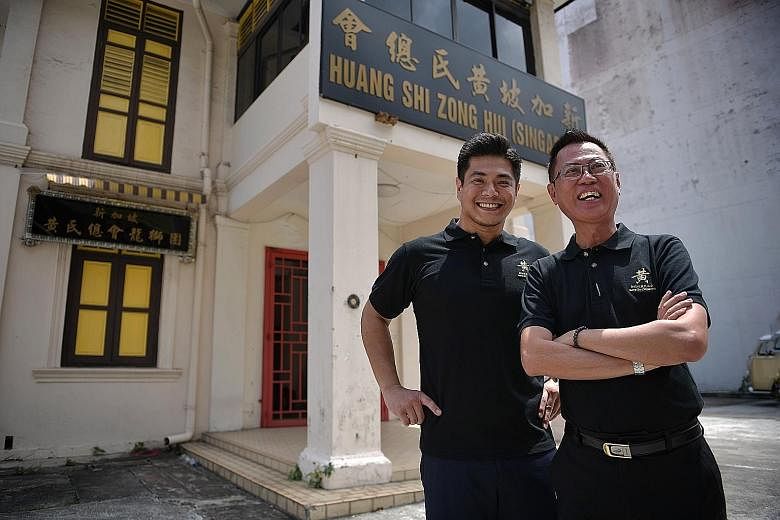SINGAPORE - In the early days of Singapore's independence, the Chinese community here was often placed into neat categories by academics and political leaders:. English-educated who are outgoing and racially integrated; Chinese-educated who are introverted and hardworking; working-class heartlanders; or bilingual cosmopolitans, and so on.
But after more than 50 years of development, and against the backdrop of a rising China, what defines a Chinese Singaporean has become complex and fluid.
Today, while the Chinese Singaporean continues to indulge in local hawker fare like chicken rice, and mark Chinese New Year by tossing yusheng (raw fish salad), he finds himself at the crossroads of a global power shift from the West to the East; of a revival of interest in dialects and the mother tongue in a society where English is entrenched; and increased awareness of the need for candid conversations about race relations.
This week's Insight looks at how the Chinese Singaporean identity evolved.
1. The rise of China
China, which opened up after the Cultural Revolution and underwent extensive economic reforms and industrialisation in the 1970s, is now an economic force to be reckoned with. But as more Singaporeans and companies flock to the growing superpower, and develop a stronger sense of cultural affinity with Chinese nationals, it has also sparked worries that such external influence can encroach on the Singapore national identity - and even possibly lead to divided loyalties.
Leaders here, meanwhile, have highlighted how the Chinese Singaporean cultural identity is one that is distinct from a greater Chinese sense of identity.
However, the situation on the ground is less straightforward, said observers like NTU Emeritus Professor Eddie Kuo. It is not so easy to draw a clean line between the two categories.A strengthening sense of ethnic pride from this sense of cultural affinity with China's rise may not be in competition with a local Chinese identity shaped by developments in Singapore.
Others, like Parliamentary Secretary of the Ministry of Culture, Community and Youth Baey Yam Keng, said that engaging with a globalising China can allow it and the rest of the world to better understand Singapore's multi-lingual, multi-cultural context.
2. The role of Special Assistance Plan (SAP) schools in preserving Chinese heritage and culture

The linguistic terrain in Singapore has shifted, and along with that change, some have questioned if this will hinder the work of SAP schools. Set up in 1979, these schools preserve the heritage of Chinese-medium schools and provide an environment for students to learn both English and Chinese as first languages.
While census data showed that in 1957, less than 2 per cent of Singapore's then population of about 1.4 million spoke English at home, English has now become the language that is now mostly commonly spoken at home, with the figure growing to about 37 per cent in 2015, according to the General Household Survey.
And while the share of those who spoke Mandarin at home was 34.9 per cent in 2015, English is likely to overtake Mandarin as the dominant spoken language at home. Census data between 2000 and 2010 showed that growth in the share of English-speaking households has accelerated, while the pace of this has slowed for Mandarin-speaking households.
At various SAP schools now, including Dunman High School (DHS), Chung Cheng High School (Main) and Catholic High School, many students prefer to speak English in their everyday lives. School leaders say that their role in providing an immersive environment to speak and learn Mandarin has become all the more important now, given this new linguistic situation.
One longstanding concern about the 26 SAP schools here is that they may become exclusive bubbles, as they do not admit students who do not take Chinese as their mother tongue.
In recent years, DHS has made a concerted push to provide students with opportunities to interact with other races and religions. Since 2016, the school's Year 4 cohort has been visiting students at the Madrasah Aljunied Al-Islamiah over two days as part of an annual learning journey, where they can interact and learn about students' school life.
Students can also pose questions about the Malay culture and Islam that they may be shy to broach with others at dialogue sessions with DHS' conversational Malay teachers.
3. Talking about issues of race
The Chinese community remains the dominant racial group here, and many may not have frequent interactions with those of other races. For example, just two in 10 Chinese Singaporeans have a close friend who is Malay or Indian, according to a 2013 survey of 4,131 Singaporeans by the Institute of Policy Studies and OnePeople.sg.
In recent years, a number of younger Chinese Singaporeans have been fronting efforts to remind members of the community to be more aware of how they may be guilty of casual racism or actions that are insensitive to those of minority groups.
For example, the issue of "Chinese privilege" was raised by Mr Stanley Ng, 32, the secretary-general of Huang Clan Association's youth committee, to about 40 youth leaders from Chinese clans at a dialogue on racial and religious harmony conducted by OnePeople.sg chairman Janil Puthucheary last September.
The term, coined by independent scholar and activist Sangeetha Thanapal, is borrowed from the term "white privilege" in the United States. It refers to the inability to see things from the viewpoint of those who are not in the majority race.
Mr Timothy Seet, 24, the executive director of youth arts and social organisation Unsaid, has also been having more conversations on the issue of "Chinese privilege" with Chinese Singaporeans. In 2016, Unsaid conducted a social experiment called the Privilege Walk to shows how factors such as gender, race and economic background can affect a person's standing in society.
"The Chinese here often say that they don't experience racism and some may believe that racism does not exist, but being self-reflective about how others may go through experiences that are different from us is not something we do enough."
Read the full Insight feature here.
Correction note: This story was edited for accuracy.


